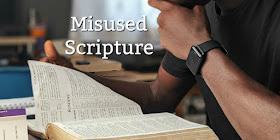Pages
▼
6 Steps to Expose False Teachings
Many false teachings are based on Scriptures taken out of context and redefined. These six steps can help expose misused passages.
1. Look at the historical background.
This is especially important with Old Testament passages that must be seen in the framework of the Old Covenant.(1)
2. Look at the context.
What subject or situation is the chapter or section addressing?(2)
3. Read it in several translations for a fuller understanding.(3)
4. Explain or write the passage in your own words.
Don't add or subtract from the meaning, just put it in your own words.(4)
5. If you have trouble understanding the passage, look it up in several credible, unbiased commentaries.(5)
Read more than one. Find the consensus.
6. Be honest enough to reject a false explanation of Scripture.(6)
Be like the Bereans and make sure whatever is taught is validated in Scripture (Acts 17:11).
Please check out 6 Ways to Determine if a Scripture is Used Correctly. It uses these six principles to expose the false teaching that Jeremiah 10:2-4 condemns Christmas trees.
--------------------------
(1) See Laws, Commands, and Errors and Why Is Historical Context Important When Studying God’s Word?
For a good example of a text that has been greatly misused by ignoring the historical background, see Jabez and the Soft Prosperity Gospel.
(2) In the Old Testament narratives and in the Gospels and Acts, what circumstances surround the passage? Who is involved? In teaching passages, who is being addressed (e.g. believers or unbelievers)? What subjects are covered before and after the passage? See Context Adds Clarity and Missing the Story Line.
(3) To see two verses that are misunderstood when read in the KJV:
Proverbs 23:7 Does Not Mean We Become What We Think and God Creates Evil??? No Way!
(4) This helps you understand if the teaching/teacher adds to or subtracts from the meaning. For example, someone might say Matthew 4:23 is a promise that Jesus will heal every sickness if we have faith. But this verse actually says that during His ministry in Galilee, Jesus healed every sickness when he was preaching. If someone claims it's a promise, they have added to the meaning.
(5) Good commentaries will approach the passage using historical background, context, original languages, and scholarly observations; but they still contain some opinion based on the scholar's doctrinal background. That's why it's helpful to research more than one. And it's important to avoid commentaries that are written to support a specific agenda, such as those written by Prosperity Gospel teachers or Hebrew Roots teachers.
(6) It can be incredibly difficult to let go of things we've been taught, even when we learn they lack credibility. But it's essential that we do so if we are going to grow in our faith. See Stubbornly Wrong.
Bible Love Notes



No comments:
Post a Comment